Top 50 things to do in Athens…
| Page 1 | Page 2 | Page 3 | Page 4 | Page 5| Full List |
There are so many great things to do in Greater Athens. Whether it’s a place you visit, a beach you go to, or simply drinking coffee next to the waves, Athens has it all!
Below is our Top 50 list. Enjoy!
[1] The Parthenon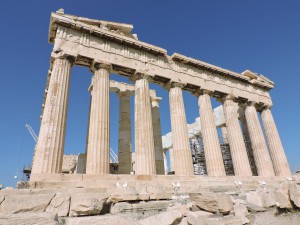
The Parthenon is the most important temple on the Athenian Acropolis dedicated to the goddess Athena built in 447 BC.
It’s a must-see when you visit Athens. Even if you’re not into history or archaeology, make sure you don’t miss this amazing monument. You will be astonished by the size and the perfect sense of proportion.
Hey, Socrates and Plato were here!
[2] The Acropolis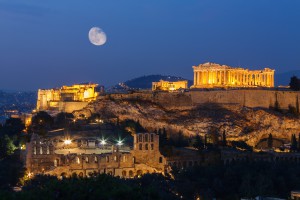
The Acropolis of Athens is an ancient citadel located on a high rocky outcrop above the city of Athens and contains the remains of several ancient buildings of great architectural and historic significance, the most famous being the Parthenon. Construction laws in Athens prohibit buildings to be higher than the Acropolis. This is why the Parthenon can be seen by almost anywhere in the city. There are 21 major archaeological remains on the top of the Acropolis that you can see, like the Old Temple of Athena, the Temple of Athena Nike, the Theatre of Dionysus, just to name a few.
[3] Ancient theatres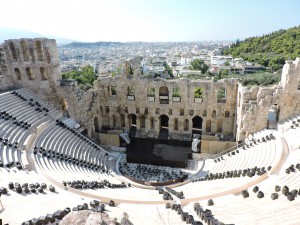
Two remarkable theatres can be seen from the top of the Acropolis, the Odeon of Herodes Atticus with a capacity of 5,000 seats, which was was built in 161 AD and renovated in 1950s. It is still used today with many concerts during the summer. Make sure you see a show when you’re in Athens.
The Theatre of Dionysus is a major open-air theatre and one of the earliest preserved in Athens. It was used for festivals in honor of the god Dionysus.
[4] Plaka 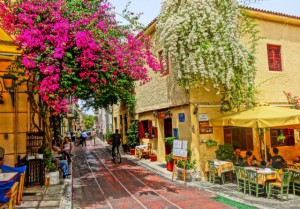
Plaka is the historic neighborhood located at the base of the hill topped by the Acropolis, with many little comberstone streets, great Greek taverns/ouzeri, cafes and souvenir shops. You will not feel that you are in a big city when walking around Plaka. Make sure you invest some time to walk and enjoy this little paradise in the center of the city. This was the city of Athens back in ancient times, so make sure you don’t miss it.
[5] Drinking Coffee!
No matter where you are in the city, a coffee shop is literally seconds away. There are probably more coffee shops in Athens than anywhere else in the world. Greece is in the top 15 countries that consume the most coffee per capita, but I truly believe that Greece is no.1.
Greeks are coffee drinkers. You hear: “Πάμε για καφέ;” which translates to: We going for coffee? Almost every few seconds, from Greeks of all ages.
It’s the national pass-time.
Order either a Frappe, Cappuccino Freddo or Espresso Freddo (basically “cold”) and you will not be disappointed. Greeks have perfected these three coffee options so make sure you try them. If you are not used to drinking strong coffee, stay away from the Frappe, unless you want to stay awake for days!
Oh, and you can sit at the coffee shop for hours, so no need to rush!
[6] Roof-Tops
So many great roof tops in Athens where you can enjoy your coffee, have a drink or even eat a great meal while over-looking the Acropolis. A for Athens Hotel, Galaxy Bar at the Hilton, 360 Cocktail Bar are just a few roof-tops where you can enjoy the city. There are so many bars spread out all over downtown. What’s better than having a drink and looking at a Wonder of the World that was built approximately 2500 years ago?
great meal while over-looking the Acropolis. A for Athens Hotel, Galaxy Bar at the Hilton, 360 Cocktail Bar are just a few roof-tops where you can enjoy the city. There are so many bars spread out all over downtown. What’s better than having a drink and looking at a Wonder of the World that was built approximately 2500 years ago?
[7] Athens Beaches
Attica (Greater Athens) is surrounded by water, so it’s no surprise that there are some great beaches to visit. Most tourists visiting Greece think that only the Greek islands have good beaches, but Attica has some of the best 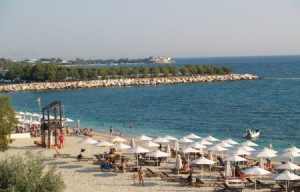 beaches in Greece!
beaches in Greece!
From public and free to the privately operated ones where an admission fee is charged for the services, many great beaches can be found minutes away from the Greek capital. The nearest beach to downtown Athens is only 8 km away!
Click here to get more information about the Athens beaches.
[8] Syntagma Square
Syntagma Square (Greek: Πλατεία Συντάγματος, pronounced [platia sindagmatos], “Constitution Square”), is the 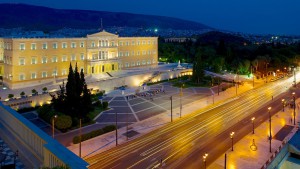 central square of Athens. It is located in front of the 19th century Old Royal Palace, housing the Greek Parliament since 1934. Syntagma Square is the most important square of modern Athens from both a historical and social point of view, at the epicenter of commercial activity and Greek politics.
central square of Athens. It is located in front of the 19th century Old Royal Palace, housing the Greek Parliament since 1934. Syntagma Square is the most important square of modern Athens from both a historical and social point of view, at the epicenter of commercial activity and Greek politics.
Syntagma Square is also a hub for many forms of public transportation in Athens; Metro lines 2 and 3 of the Athens Metro have a stop at the Syntagma station, the Athens Tram also stops here, and buses or trolley-buses are available to many places in the city. You can also reach the Athens Airport using the metro lines.
Make sure you visit the Tomb of The Unknown soldier on the base of the Parliament and make sure you see the changing of the Guards (Evzones)… it’s worth it!
[9] Mount Lycabettus
Also known as Likavitos (Greek: Λυκαβηττός), is a limestone hill in Athens at 300 meters above sea 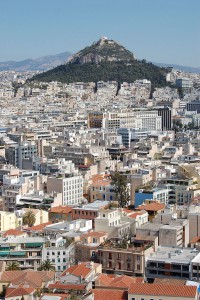 level.
level.
You can drive, walk or take the funicular rail all the way to the top of the hill (the railway station can be found at the corner of Ploytarchou and Aristippou streets in Kolonaki).
It’s a steep walk, therefore it’s preferable if you take the funicular railway up, and come down by foot. Your feet will not be happy in the morning if you decide to walk it to the top. Trust me!
Pine trees cover its base, and on its peak you will find the 19th century Chapel of St. George, a theatre, and a cafe/restaurant.
Once on top you will be amazed by the view. You can see the whole city from up there! The Parliament, the Olympic Stadium, the Piraeus port, the sea, a few Greek islands and of course the Acropolis.
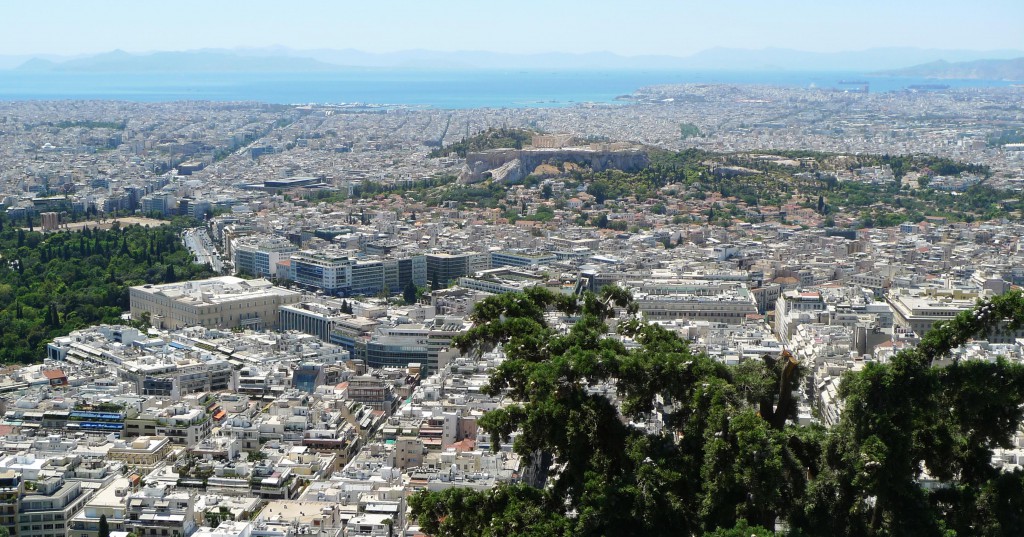
[10] The Acropolis Museum
A beautiful building full of history! 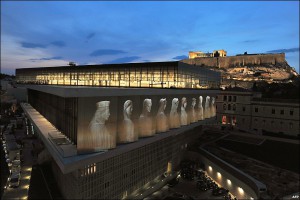
The museum opened its doors to the public on 20 June 2009. Nearly 4,000 objects are exhibited focused on the findings of the archaeological excavations of the Acropolis of Athens. The museum was built to house every artifact found on the rock and on its feet, from the Greek Bronze Age to Roman and Byzantine Greece. It’s preferable if you visit the museum before visiting the Acropolis as it’s an introduction of the history, art and architecture. Basically you will understand more details when you see the Acropolis if you learn a bit more about its history here.
The museum is located at the southeastern slope of the Acropolis hill just a few meters away, on the ancient road that led up to the “sacred rock” in classical times. The entrance to the building is on Dionysiou Areopagitou Street and directly adjacent to the Akropoli metro station (the red line of the Athens Metro).
Tip: The museum is fully-air-conditioned, so make sure you visit when the temperature in Athens is blazing hot.